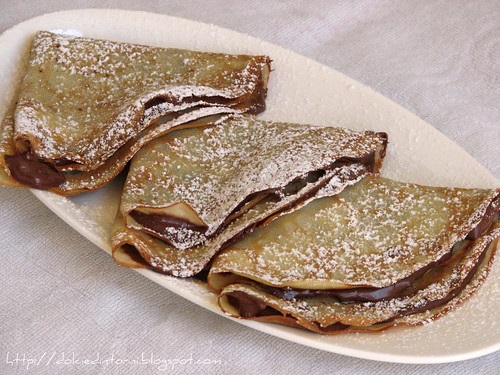Directions
Preheat oven to 375 degrees F (190 degrees C). Butter and flour
12 (3 inch) madeleine molds; set aside.
Melt butter and let cool to room temperature.
In a small mixing bowl, beat eggs, vanilla and salt at high
speed until light.
Beating constantly, gradually add sugar; and continue beating at
high speed until mixture is thick and pale and ribbons form in bowl when
beaters are lifted, 5 to 10 minutes.
Sift flour into egg mixture 1/3 at a time, gently folding after
each addition.
Add lemon zest and pour melted butter around edge of batter.
Quickly but gently fold butter into batter. Spoon batter into molds; it will
mound slightly above tops.
Bake 14 to 17 minutes, or until cakes are golden and the tops
spring back when gently pressed with your fingertip.
Use the tip of the knife to loosen madeleines from pan; invert
onto rack. Immediately sprinkle warm cookies with granulated sugar. Madeleines
are best eaten the day they're baked. Leftover madeleines are wonderful when
dunked into coffee or tea.

Another famous part of French baking is the crepe. Crepe are widely available in France, They are like big thin pancakes and can be filled with nearly anything so they can be sweet or savoury. Crepes again are made with simple, widely available ingredients. A recipe follows below from nigella.com
Ingredients

Ingredients
- 30 grams unsalted butter melted (plus more for frying)
- 150 grams plain flour
- 325 ml milk
- 1 large egg
Method
- The best thing to have to make proper crêpes is a copper crêpe pan. Melt the butter and let cool a little.
- Pour the flour into a bowl, whisk in the egg and milk and finally, just before making the crêpes, the melted butter.
- Heat a seasoned crêpe pan or the nearest equivalent (I like to melt some butter in one first, and then wipe it all off) and ladle 2–3 tablespoons of batter into the pan then quickly hold it up and swirl so that the batter forms a quick, thin pancake covering the base of the pan. This will cook in a minute so flip it and cook for 30 seconds to a minute on the other side, then remove the pale crêpe to a layer of baking paper.
- Continue with the rest of the batter. This is the work of moments, and crêpes, ready filled, or empty, reheat very well in a microwave.

France is also very famous for its patisseries, especially the croissant. The croissant is a very technical baked good to make and you will find the best ones in France! It is made with simple ingredients. Below follows recipe for the croissant.
Ingredients
- Makes 8 croissants
- 2 cups (250g) strong bread flour
- 1 1/4 sticks sticks (150g) cold unsalted butter, cubed
- 1/2 cup (120 ml) lukewarm milk
- 3 tbsp (45 g) sugar
- 25 g fresh yeast (7 g- active dry yeast)
- 1/2 tsp salt
- Egg Wash
- 1 egg yolk
- 1 tbsp milk
Directions
- Place yeast in a bowl. Add sugar and stir until it liquefies. Add milk and set aside to cool completely.
- Combine flour and salt into a large bowl. Add butter and using a fork combine until big crumbles form.
- Add the yeast/milk mixture and gently combine until the dough just comes together. The butter needs to remain in pea-sized pieces. Wrap it with plastic, knead slowly to form a square and freeze for 30 minutes or refrigerate for a couple of hours.
- Dust with flour your work surface and your rolling pin and start rolling the dough into a rectangular roughly two to three times as long as it is wide. The dough it pretty hard to work with at the beginning but will come together while rolling and folding.
- Fold the short sides of the dough into the middle. Rotate the dough by a quarter turn. Roll out slightly to lengthen. Fold the short ends towards the middle.
- Flip the dough over so the seams are underneath. Repeat the rolling and folding process steps 4-5, three more times, giving the dough a total of four times of rolling and folding.
- Wrap the dough in plastic wrap and refrigerate for a couple of hours or better overnight.
- On a lightly floured surface roll the dough into a rectangular of 16 inches (40cm) X 10 in (25 cm). Cut the dough into triangles, it will make about 8 triangles of 12 in (30 cm) long and 3 in (8 cm) at base.
- Score a small slit in the centre of each triangle base, gently stretch the corners and tip, then roll the croissant starting from the wide up to the top giving them the croissant shape.
- Place the croissants with tip side down onto a prepared baking sheet lined with parchment paper. Cover with plastic wrap and let rise for 2-3 hours at room temperature.
- Preheat the oven to 450 F (230C). Brush the croissants with egg wash.
- Bake for 8 minutes than reduce the oven to 375 F (190C) and bake for another 10-15 minutes until deep golden brown.
- Cool on wire rack before serving.
Yum! But why do they have these deserts?
ReplyDeleteBecause the necessary ingredients are widely available in this country.
DeleteI'll have to try out one of these recipes
ReplyDelete